 |
|---|
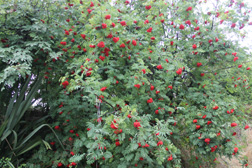 | After our first night in Queenstown, it became obvious that Pegah and I had slightly different agendas. I had previously published a day by day and turn by turn itinerary of where I planned to go and what I planned to see, which were mostly sites in Middle Earth for The Lord of the Rings and The Hobbit. Pegah, on the other hand, wanted to see New Zealand. We compromised by appointing her the photographer for the trip, while I pointed out places I wanted to remember and took the photos of her. One of the results is this pair of photos that have absolutely nothing to do with hobbits or Middle Earth, but a great deal to do with documenting the natural beauty for which New Zealand is justly famous.
| 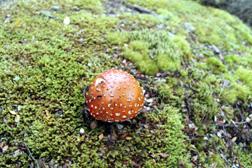 |
 | Another photographing problem that arose was that of finding people to take pictures of us together. On this trip to Te Anau, for example, we encountered very few other people at the places we wanted to visit and along the way. There were other people about, they were just doing other things. In most cases, it seemed to have been impolite, to say no more, to interrupt them. We were fortunate, therefore, to find a rest stop and scenic vantage point along Lake Wakatipu where another couple had stopped to take pictures. Unlike us, they had a vehicle specifically designed for cruising along the winding New Zealand roads. In addition, their vehicle, unlike ours, appeared to have been lovingly maintained.
| 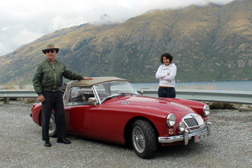 |
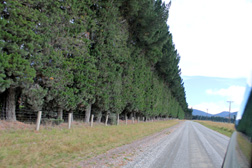 | One ubiquitous feature we noticed were the long shelterbelts, or windbreaks, to protect stock and crops from the wind. They are as long as practical and can contain many different plant species. I am told that the professional trimmers, even with their expensive equipment, make a fortune pruning them. This one seems to have overgrown the range of the pruning equipment. The flat land on the right behind Pegah demonstrates the need for shelter from the wind. This particular area was used as the set where the Riders of Rohan burned the bodies of the Uruk-hai that had captured Merry and Pippin in The Two Towers. The trees behind her are part of the woodland of Fangorn Forest into which the two hobbits escaped just before the Eomer and his riders arrived.
| 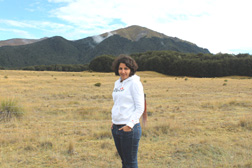 |
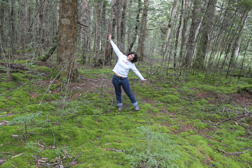 | Speaking of Fangorn Forest, here Pegah is having fun in two of the locations used in the film. On the left she is demonstrating the direction in which the young trees are leaning, due, no doubt, to the influence of the prevailing wind. There is no shelterbelt here. On the right, the forest is older and more dense, with new growth interspersed with old, established trees and fallen limbs covered with moss and lichen. In LOTR, Fangorn was the last of the great primeval Middle Earth forest. Legolas remarked that he felt it was very ancient and aware of their intrusion. "They have feelings, my friend," he told Gimli. "The elves began it, waking up the trees, teaching them to speak."
| 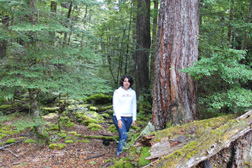 |
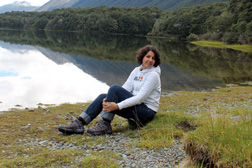 | Our next stop was South Mavora Lake, a popular hiking and camping location and also the filming site of Nen Hithoel in The Fellowship of the Ring. The Anduin River fed the lake through the Argonath and plunged over the Falls of Rauros on its way to the Bay of Belfalas. Here Pegah is relaxing beside the lake, which was actually the north end in the film. On the right, Pegah took what I consider is a perfect representation of Nen Hithoel. The far end of South Mavora Lake is actually a rocky mud flat with a little trickle of water feeding into the lake. One can imagine a great waterfall there, over which the Anduin River plunges on its way to the sea, certainly a far cry from this placid little lake.
| 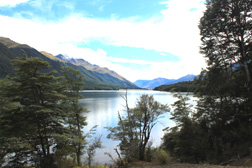 |
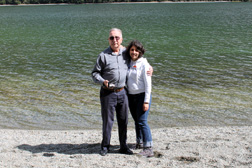 | Here Pegah and I are standing at the Mavora Lakes location of the site where the Fellowship camped, before being attacked by Uruk-hai, and the death of Boromir. We were fortunate to met a couple of bicycle riders to take a picture of us together. I am using my GPS receiver to find the exact spot reported by Ian Brodie in his Lord of the Rings Location Guide Book. On the right, Pegah took a picture of the site where Frodo left the Fellowship to make his way across the lake on his way to Mordor and Sam nearly drowned following him. This took great courage. Like almost all hobbits, neither Frodo or Sam could swim, and Frodo's parents had been killed in a boating accident when he was young.
| 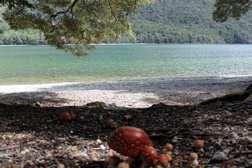 |
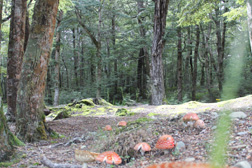 | Here is the same location from the other side, with the small patch of mushrooms for reference. This site was used in LOTR for the the place where Merry and Pippin challenged the Uruk-hai and the large tree behind which Frodo hid from them. It was also used to film Lurtz and his band running on their way to the lake.
The area is obviously a popular hiking spot, for the woodland trails are well traveled. I suspect that many hikers are visitors like us, looking for spots they recognize from the films. Here Pegah is standing on a steep slope, pretending to bait the Uruk-hai.
| 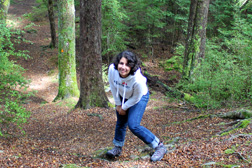 |
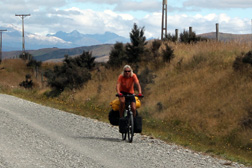 | New Zealand is famous for its outdoors activities, and some of the best camping and backpacking equipment in the world is made and sold here. Even in the smallest cities, there are promotions for all kinds of hiking, biking, camping and tramping experiences. Almost every little path in the wilderness is some sort of established track or trail to a camping area, with toilets and rubbish disposal facilities thoughtfully provided by local authorities. We constantly met individuals like this lone bicyclist or couples of hot, dusty, people, happily plodding along in the the most unlikely places, such as the location near Te Anau of this distinctive mountain, The Carrock, the backdrop for Beorn's house, in The Hobbit.
| 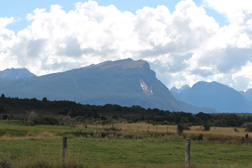 |
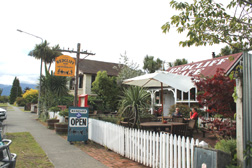 | We arrived in beautiful, romantic Te Anau about 5:30 in the evening and took a stroll to enjoy the sunset and verify the location of St. Bernard Catholic church, where I planned to introduce Pegah to Catholic mass. We passed the famous Redcliff Cafe, where the LOTR cast spent their evenings while in Te Anau. The city is used as a base for the Kepler Track, a four day, 47 mile tramping loop from the city. There is also kayaking, cycling, jet boat riding, fishing and hunting, farm tours and seaplane/helicopter sightseeing. Due to our schedule, we didn't get to do any of these things, but we did get to enjoy the beautiful scenery. Pegah prepared a delicious dinner for us to enjoy in our traveling home. |  |
| Click here to go to the next page. |
|---|


















